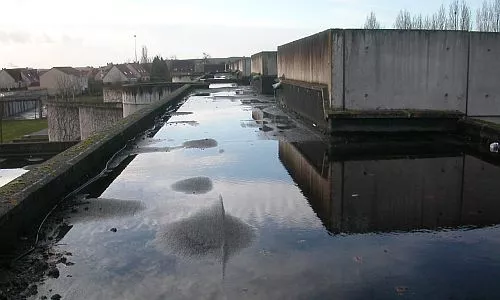Specifying FOAMGLAS® insulation for moisture resistance

Water, in the form of rainwater, ground water or even moisture vapour, can pose a significant risk to buildings and industrial installations.
Insulation for high humidity applications
Specifying insulation appropriate for high humidity environments is critical. Airtightness and resistance to vapour diffusion are important characteristics when the vapour pressure is high or where the humidity needs to be carefully controlled (such as a wine cellar).
Examples of hard-to-insulate areas include swimming pools, spa facilities, laundries and professional kitchens, as well as bathrooms, shower rooms, and basements. Areas featuring the handling of chemicals, paper, petroleum and food also need consideration.
Over time, conventional insulation materials will struggle to maintain their performance in these applications. Floors, walls and roofs insulated with FOAMGLAS® cellular glass, however, resist the movement of moisture vapour and the insulation remains dry in all conditions.
Design and specification of watertight flat roofs
Designing and constructing flat roofs to be watertight depends on good workmanship, careful detailing of the waterproofing membrane, and achieving the correct drainage falls.
Should a leak occur in the roof covering due to damage or poor installation, water can enter the roof build-up. It passes through and along the layers of the construction, potentially tracking a long way from the leak and causing widespread damage. If water is seen inside the building, the location often does not correspond with the location of the leak, making it hard to find where water has entered the building.
If the drainage slope (falls) are too shallow, the roof will not shed water effectively. Ponding water imposes extra loading on the roof, is a safety risk for anybody who needs to access the roof, and ponding water can become stagnant.
Specifying FOAMGLAS® insulation provides a flat roof with a watertight insulation layer. The water cannot track through the roof construction away from the leak, and the insulation does not become sodden. FOAMGLAS® cellular glass remains watertight for the life of the building, and a further benefit is that a separate vapour control layer (VCL) is not required.
Thermal insulation for floors and below ground applications
Repairing or replacing thermal insulation, once installed, is difficult in most building elements. However, it is particularly difficult in floors and below ground applications, making correct specification and installation even more critical. The selected insulation needs to be durable, able to maintain its performance, and capable of being in direct contact with the ground.
FOAMGLAS® cellular glass insulation meets all of these criteria. It has a high compressive strength capable of protecting against constant pressure from the ground, and bearing the weight of a load-bearing floor slab above. It is unaffected by direct contact with soil, and maintains its thermal performance, even in the event of being in below ground conditions with high levels of water.
Installed below a ground floor slab, FOAMGLAS® layer removes the need for a damp proof membrane (DPM), and is resistant to chemicals in contaminated ground, humic acids, micro-organisms, rodents and insects.
Specifying durable and well-insulated facade solutions
External walls and facades are exposed to frost, heat, wind and driving rain. Perforated Cladding, and Rainscreen systems, provide moderate protection from the weather. Moisture, wind and rain can easily enter the air space behind these external finishes.
The insulation behind the external cladding typically has a shorter service life than the cladding itself. The unique characteristics and proven durability of FOAMGLAS® insulation ensure the building is has long term protection from the weather.
Moisture resistant insulation solutions for industrial applications
Industrial applications feature water sources other than the weather. Examples include sprinkler system testing, deluge testing, cleaning or rinsing, mist from cooling towers, water dripping from cold equipment, flooding during construction, and testing a cold or cooled water system.
As a result of building systems being tested at an early stage, before the installation is fully completed, test water can penetrate any nearby insulation system. Deficient design, poor workmanship, damage, or substandard maintenance procedures, can also result in water ingress. Insulating industrial equipment can be difficult due to flanges, nozzles, manholes, ventilation openings and support brackets. These all increase the chance of water ingress.
High and low temperature applications introduce their own challenges. In cold environments, water vapour can condense in the cells of organic foam insulation, significantly increasing water absorption. In high temperature applications, water can saturate ‘waterproof’ fibrous and cementitious insulation.
Once saturated, they retain the moisture even in the hot conditions - it does not evaporate, and insulating performance is reduced.
Low temperature tanks experience increased evaporation, while there is a greater risk of solidification of some materials in pipes designed to work at high temperatures.
Water in thermal insulation systems leads to increased heat loss, corrosion (especially where excessive concentrations of chlorides and other chemicals are present), and even dimensional changes in the material that affect the integrity and safety of the installation.
FOAMGLAS® have developed a variety of insulation systems for underground pipe installations, all of which are waterproof and capable of withstanding groundwater. Combined with the inherent non-combustibility of cellular glass, FOAMGLAS® insulation is an ideal material for offshore platforms, tankers, shipyards and other environments where there is an abundance of water.
Conclusion: moisture resistance of FOAMGLAS®
Thanks to its cell structure, FOAMGLAS® cellular glass insulation is completely waterproof and vapour tight. Leaks are easily detected as water cannot penetrate the system, and the insulation does not absorb water. The thermal performance of the system remains the same for the lifetime of the installation.










